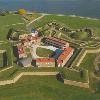

|
This is a detail from the source map showing the the layout of Fort Ticonderoga Tags: Fort Ticonderoga View |
Tags: Fort Ticonderoga View |
Tags: Fort Ticonderoga View |
|||||||||
Fort Ticonderoga, formerly Fort Carillon, is a large 18th-century fort built at a narrows near the south end of Lake Champlain in upstate New York in the United States. It was constructed by the French between 1754 and 1757 during the Seven Years War, often referred to as the French and Indian War in the USA, and was of strategic importance during the 18th-century colonial conflicts between Great Britain and France, and again to a lesser extent during the American Revolutionary War.
The site controlled a river portage (portage) alongside the mouth of the rapids-infested La Chute River in the mi to km3.5abbr=no between Lake Champlain and Lake George (Lake George (New York)) and was strategically placed in conflicts over trade routes between the British-controlled Hudson River Valley and the French-controlled Saint Lawrence River Valley. The terrain amplified the importance of the site. Both lakes were long and narrow, oriented north-south, as were the many ridge lines of the Appalachian Mountains extending as far south as Georgia (Georgia (U.S. state)), creating the near-impassable mountainous terrains to the east and west of the Great Appalachian Valley that the site commanded. The name "Ticonderoga" comes from the Iroquois (Iroquoian languages) word tekontar�:ken, meaning "it is at the junction of two waterways".
During the 1758 Battle of Carillon, 4,000 French defenders were able to repel an attack by 16,000 British troops near the fort. In 1759, the British returned and drove a token French garrison from the fort merely by occupying high ground that threatened the fort (Battle of Ticonderoga (1759)). During the American Revolutionary War, the fort again saw action in May 1775 when the Green Mountain Boys and other state militia under the command of Ethan Allen and Benedict Arnold captured (Capture of Fort Ticonderoga) it in a surprise attack. The Americans held it until June 1777, when British forces under General John Burgoyne again occupied high ground above the fort (Siege of Fort Ticonderoga (1777)) and threatened the Continental Army troops, leading them to withdraw from the fort and its surrounding defenses. The only direct attack on the fort took place in September 1777, when John Brown (John Brown of Pittsfield) led 500 Americans in an unsuccessful attempt to capture the fort from about 100 British defenders.
The British abandoned the fort following the failure of the Saratoga campaign, and it ceased to be of military value after 1781. It fell into ruin, leading people to strip it of some of its usable stone, metal, and woodwork. It became a stop on tourist routes of the area in the 19th century. Its private owners restored the fort early in the 20th century. A foundation (foundation (charity)) now operates the fort as a tourist attraction, museum, and research center.
Nrhp Type: nhl
Birth Location: Ticonderoga (village), New York, Ticonderoga, New York, NY
Nearest City: Burlington (Burlington, Vermont), VT (Vermont)
Locmapin: New York Adirondack Park
Lat Degrees: 43 lat_minutes = 50 lat_seconds = 29 lat_direction = N
Long Degrees: 73 long_minutes = 23 long_seconds = 17 long_direction = W
Map Width: 300
Map Alt: The fort is located by Lake Champlain in New York near the Vermont border, about 2/3 of the way north from New York City to Montreal.
Area: convert21950acre
Built: 1755-1758
Architect: Marquis de Lotbini�re (Michel Chartier de Lotbini�re, Marquis de Lotbini�re)
Architecture: Vauban-style fortress
Designated Nrhp Type: October 9, 1960
Added: October 15, 1966
Refnum: 66000519
Battles: 1758 (Battle of Carillon) - 1759 (Battle of Ticonderoga (1759)) - 1775 (Capture of Fort Ticonderoga) - 1777 (Siege of Fort Ticonderoga (1777)) Fix bunchingend

